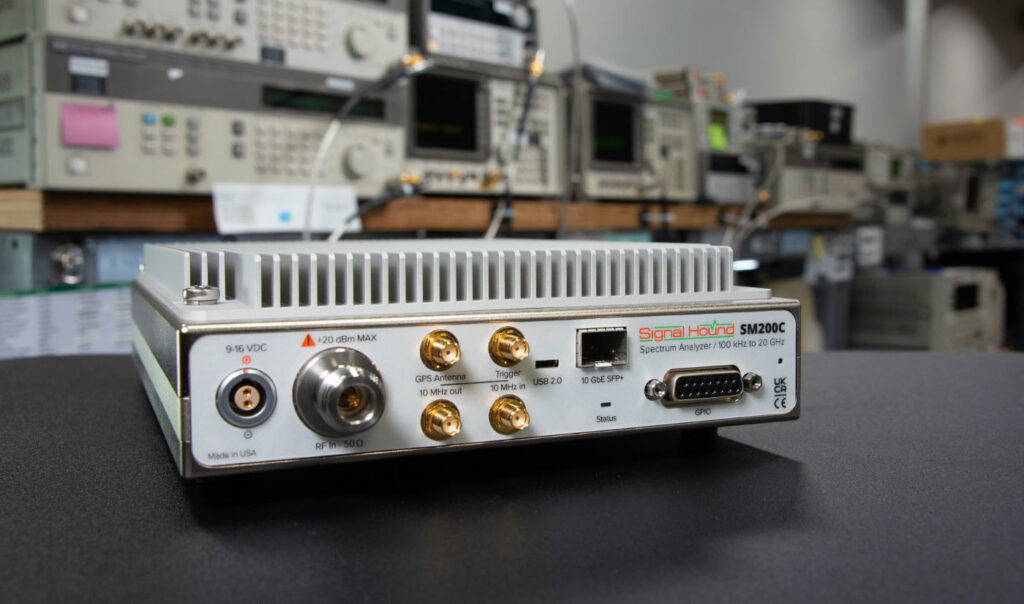Unmanned Aerial Vehicles (UAVs), or drones, are no longer just for military and hobbyists. According to the FAA, 369,528 commercial drones are registered in the United States as of 12/31/20231. As commercialized use cases for UAVs continue to expand, the need for aerial surveillance also increases. Of particular importance is protecting the safety of military installations, but maintaining safe airspace around government facilities, airports, public gatherings, and critical infrastructure is also essential.
Most commercial drones communicate with their ground controllers using RF signals in one (or more) of the unlicensed bands: 2.4 GHz, 5.8 GHz, 900 MHz and 433 MHz, with 2.4 GHz being the most common. Drone signals can frequency hop in those bands and can consume up to 80 MHz of bandwidth. A spectrum analyzer can detect RF signals emitted by UAVs as they communicate with their operators and can even detect multiple devices of concern at once. Furthermore, by using multiple spectrum analyzers, it is possible to triangulate the signals and locate the UAV and operator simultaneously.

Signal Hound’s SM200C real-time spectrum analyzer (RTSA) with a wide frequency range from 100 kHz to 20 GHz, 160 MHz instantaneous bandwidth, Terahertz sweep speed, fiber optic interface, and internal GPS is ideal for detecting, locating, and identifying UAVs.
While RF-based detection is considered highly effective for UAS detection, there are some challenges to using this approach. The more crowded the spectrum, the harder it is to identify signals of interest. Receiver selectivity is the key property when analyzing crowded spectrum. Selectivity is the ability to distinguish between the signal a receiver is tuned to and the signals the receiver is not tuned to. The added pre-selector of the SM200C in addition to our optimizing for excellent IP3, DANL, phase noise, and SFDR improves our selectivity allowing us to bring clarity to noisy spectrum – making it a reliable tool for surveilling crowded spectrums.
The majority of commercial drones use WiFi protocols for command and control that can consume a large swath of bandwidth. Once you have solved the problem of tuning in to the signal of interest, the SM200C’s 160 MHz of streaming bandwidth allows you to focus in on the entire signal, decoding down to the payload. That payload includes MAC addresses common to certain drone manufacturers, GPS location data, and possibly even video. With this data, identifying the manufacturer of the drone is simple.
The SM200C’s terahertz sweep speed allows you to frequency hop in the unlicensed bands quickly, providing a very fast, very efficient mechanism for scanning those bands for drone activity. Now, a single device can scan the most common bands hunting for drone activity, alerting the operator when drone activity is detected. The ability to do this fast significantly impacts the probability of intercept (POI). The ability to complete this task easily and effectively is a hallmark of the Signal Hound SM product line.
There are many challenges when it comes to spectrum monitoring for UAV detection and identification. One in particular is that physical obstacles such as rugged terrain or tall buildings can limit the range of the spectrum analyzer. Often antenna placement alone can’t overcome this while still providing good site coverage, making installation of multiple monitors across a site the optimal solution. The SM200C’s extremely low SWaP (7.45″ x 4.51″ x 1.81″ / 1.1lbs), internal GPS for monitoring station location, fiber optic interface for station placement logistics optimization and highly competitive pricing, makes it ideal for site wide deployment and monitoring applications.
As military and commercial use cases for UAVs expand rapidly, the ability to detect and locate them quickly and accurately becomes essential. Signal Hound’s SM200C stands out as a powerful tool for surveilling and maintaining the safety and security of military installations, critical infrastructure and public spaces.
- https://www.faa.gov/node/54496 Federal Aviation Administration Drones by the Numbers (as of 12/31/2023).
- https://www.mdpi.com/1424-8220/24/1/125 MDPI Advances and Challenges in Drone Detection and Classification Techniques: A State-of-the-Art Review